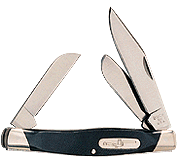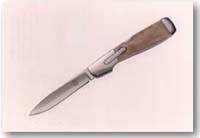
KNIVES
Your best camp tool and daily tool will be your pocket knife. They come in many shapes and sizes. Find one that you can safely handle. A well maintained knife will last your lifetime.

A. NAME THE PARTS OF A KNIFE.



Taken from BSA Handbook, 10th Ed., 1990



Use a proper wetstone for your knife. A real professional will have several stones. Some for rough work, and finer-grained stones for finish work. Always use oil when sharpening.
Always keep your knife sheathed. This provides safety for you, as well as protection for your knife from rust or loss.


B. DEMONSTRATE HOW TO SHARPEN A KNIFE.
From a safety perspective, be watchful of where your fingers are holding your wetstone. I have seen and had many cuts due to careless sharpening. There are other types of devices now on the market, such as ceramic rods that have set angles for sharpening. You need simply to drag your blade through them. If using a wetstone, use it wet with honing oil (at home), or saliva if nothing else is available in the field.
Keeping your knife sharp will keep you safe, as well as protect your knife from damage such as knicks. You want to sharpen most knives with a 23 degree angle. As many sharpening strokes as you do to one side of the blade, you should perform to the other. Adventures in Camping shows the circular motion to sharpen knives.
C. DESCRIBE FIVE DIFFERENT TYPES OF KNIVES AND THEIR PURPOSES.
Knives are becoming vary diverse. Above to the right are pictured several types. Starting from the top:
1) Lockblade Pocket Knife - A utility knife with a blade-locking mechanism to provide safety to the user.
2) Folding Hunter's Knife - A knife used by hunters to debone, skin and cut up prey.
3) Fillet Knife - A knife used by fishermen to debone, remove scales and prepare fillets of fish.
4) Hunter's Sheath Knife - A knife used by hunters of larger game to skin and field dress prey.
5) Folding Lockblade - Same as above.
6) Leatherman Tool - A multipurpose tool with at least a utility blade. Used by construction men, etc.
Pictured at top left is the classic Buck Pocket Knife. It is used for basic utilitarian use.
Below are the Boy Scout Knife and Swiss Army Knife. Both are pocket knives and have uses based upon their attachments.
D. EXPLAIN THE SAFETY FACTORS IN USING AND PASSING A KNIFE.
To use your knife safely could save your life or limb, or that of those around you.
To open a pocketknife, firmly grasp the handle with one hand, and using your other hand as shown open the blade. If the knife has a fingernail groove, use it.
To close the knife, reverse the process, being careful to not close the knife on your fingers.
When using a pocketknife, never put your thumb on the back of the blade. If the knife leaves the cut, then the blade is likely to close on your hand. You may also be hurt by shavings or splinters. It is a good practice to follow even if using a sheath knife or lock blade. Always cut away from you and others nearby. Always keep your blade sharp and don't use the tool for a purpose for which it was not intended, such as prying.
When passing a knife, there are a few things to keep in mind. Pass a folding knife closed if possible. Never hold the blade with the edge inward towards your palm when passing a knife. Pass an open knife or sheath knife as pictured to the right.
I always teach to pass the tool, any tool, with the bodies of the giver and receiver squared up with each other. My right arm goes to your left arm, and my left arm to your right arm. This keeps it simple for younger kids or those with dislexia.
Common sense is the key to passing the tool safely. The receiver should always acknowledge control of the blade and tool by saying thank you to the giver.


To Adventures in Camping - Toolcraft
Under Construction